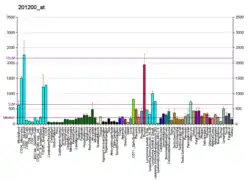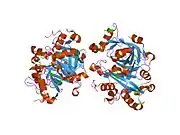CREG1
Protein CREG1 (Cellular Repressor of E1A-stimulated Genes 1) is a protein that in humans is encoded by the CREG1 gene.[5][6]
| CREG1 | |||||||||||||||||||||||||||||||||||||||||||||||||||
|---|---|---|---|---|---|---|---|---|---|---|---|---|---|---|---|---|---|---|---|---|---|---|---|---|---|---|---|---|---|---|---|---|---|---|---|---|---|---|---|---|---|---|---|---|---|---|---|---|---|---|---|
 | |||||||||||||||||||||||||||||||||||||||||||||||||||
| |||||||||||||||||||||||||||||||||||||||||||||||||||
| Identifiers | |||||||||||||||||||||||||||||||||||||||||||||||||||
| Aliases | CREG1, CREG, cellular repressor of E1A stimulated genes 1 | ||||||||||||||||||||||||||||||||||||||||||||||||||
| External IDs | OMIM: 618055 MGI: 1344382 HomoloGene: 31199 GeneCards: CREG1 | ||||||||||||||||||||||||||||||||||||||||||||||||||
| |||||||||||||||||||||||||||||||||||||||||||||||||||
| |||||||||||||||||||||||||||||||||||||||||||||||||||
| |||||||||||||||||||||||||||||||||||||||||||||||||||
| |||||||||||||||||||||||||||||||||||||||||||||||||||
| |||||||||||||||||||||||||||||||||||||||||||||||||||
| Wikidata | |||||||||||||||||||||||||||||||||||||||||||||||||||
| |||||||||||||||||||||||||||||||||||||||||||||||||||
The adenovirus E1A protein both activates and represses gene expression to promote cellular proliferation and inhibit differentiation. The protein encoded by this gene antagonizes transcriptional activation and cellular transformation by E1A. This protein shares limited sequence similarity with E1A and binds both the general transcription factor TBP and the tumor suppressor pRb in vitro. This gene may contribute to the transcriptional control of cell growth and differentiation.[6]
References
- GRCh38: Ensembl release 89: ENSG00000143162 - Ensembl, May 2017
- GRCm38: Ensembl release 89: ENSMUSG00000040713 - Ensembl, May 2017
- "Human PubMed Reference:". National Center for Biotechnology Information, U.S. National Library of Medicine.
- "Mouse PubMed Reference:". National Center for Biotechnology Information, U.S. National Library of Medicine.
- Veal E, Eisenstein M, Tseng ZH, Gill G (Sep 1998). "A Cellular Repressor of E1A-Stimulated Genes That Inhibits Activation by E2F". Mol Cell Biol. 18 (9): 5032–41. doi:10.1128/mcb.18.9.5032. PMC 109088. PMID 9710587.
- "Entrez Gene: CREG1 cellular repressor of E1A-stimulated genes 1".
External links
- Human CREG1 genome location and CREG1 gene details page in the UCSC Genome Browser.
Further reading
- Veal E, Groisman R, Eisenstein M, Gill G (2000). "The secreted glycoprotein CREG enhances differentiation of NTERA-2 human embryonal carcinoma cells". Oncogene. 19 (17): 2120–8. doi:10.1038/sj.onc.1203529. PMID 10815803.
- Jiang LQ, Wen SJ, Wang HY, Chen LY (2003). "Screening the proteins that interact with calpain in a human heart cDNA library using a yeast two-hybrid system". Hypertens. Res. 25 (4): 647–52. doi:10.1291/hypres.25.647. PMID 12358155.
- Strausberg RL, Feingold EA, Grouse LH, et al. (2003). "Generation and initial analysis of more than 15,000 full-length human and mouse cDNA sequences". Proc. Natl. Acad. Sci. U.S.A. 99 (26): 16899–903. Bibcode:2002PNAS...9916899M. doi:10.1073/pnas.242603899. PMC 139241. PMID 12477932.
- Di Bacco A, Gill G (2003). "The secreted glycoprotein CREG inhibits cell growth dependent on the mannose-6-phosphate/insulin-like growth factor II receptor". Oncogene. 22 (35): 5436–45. doi:10.1038/sj.onc.1206670. PMID 12934103.
- Clark HF, Gurney AL, Abaya E, et al. (2003). "The Secreted Protein Discovery Initiative (SPDI), a Large-Scale Effort to Identify Novel Human Secreted and Transmembrane Proteins: A Bioinformatics Assessment". Genome Res. 13 (10): 2265–70. doi:10.1101/gr.1293003. PMC 403697. PMID 12975309.
- Ota T, Suzuki Y, Nishikawa T, et al. (2004). "Complete sequencing and characterization of 21,243 full-length human cDNAs". Nat. Genet. 36 (1): 40–5. doi:10.1038/ng1285. PMID 14702039.
- Zhang Z, Henzel WJ (2005). "Signal peptide prediction based on analysis of experimentally verified cleavage sites". Protein Sci. 13 (10): 2819–24. doi:10.1110/ps.04682504. PMC 2286551. PMID 15340161.
- Gerhard DS, Wagner L, Feingold EA, et al. (2004). "The Status, Quality, and Expansion of the NIH Full-Length cDNA Project: The Mammalian Gene Collection (MGC)". Genome Res. 14 (10B): 2121–7. doi:10.1101/gr.2596504. PMC 528928. PMID 15489334.
- Otsuki T, Ota T, Nishikawa T, et al. (2007). "Signal sequence and keyword trap in silico for selection of full-length human cDNAs encoding secretion or membrane proteins from oligo-capped cDNA libraries". DNA Res. 12 (2): 117–26. doi:10.1093/dnares/12.2.117. PMID 16303743.
- Sacher M, Di Bacco A, Lunin VV, et al. (2006). "The crystal structure of CREG, a secreted glycoprotein involved in cellular growth and differentiation". Proc. Natl. Acad. Sci. U.S.A. 102 (51): 18326–31. doi:10.1073/pnas.0505071102. PMC 1317909. PMID 16344469.
- Gregory SG, Barlow KF, McLay KE, et al. (2006). "The DNA sequence and biological annotation of human chromosome 1". Nature. 441 (7091): 315–21. Bibcode:2006Natur.441..315G. doi:10.1038/nature04727. PMID 16710414.
This article is issued from Wikipedia. The text is licensed under Creative Commons - Attribution - Sharealike. Additional terms may apply for the media files.





